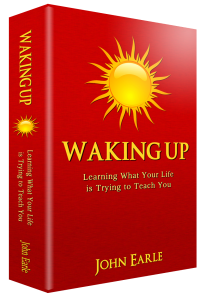It is an amazing truth that we possess all the answers to our personal dilemmas. This truth is connected to another: that our personal stories, because we created them, are our perfect teachers. To discover the reality of both these truths, we are required to take up the practice of personal responsibility.
Personal responsibility is not popular because, when we first open to the possibility that we could be responsible for everything in our life, all manner of discontent, embarrassment, shame, and other discomforts arise. We suddenly realize that we may, at least in part, be responsible for situations for which we have always blamed circumstances and others. And it is pretty hard to deny that we are responsible for our reactions and responses to a world that is forever flowing towards us. We see how unskillful we have been, and how we have habits that are not helping us to connect authentically to others and the world. Personal responsibility is the acknowledgment that, if we want these things to change, we will have to change. Change is an anathema to most of us. We prefer the comfort of the usual, that which is well known, even if it is emotionally painful. The good news is that, when we take up responsibility for our life story, we enter the powerful center of all positive change. We stop running away, denying, blaming others and circumstances for the disharmonious parts of us that are so troubling. We see clearly that the obstacles to a joyful and fulfilling life are of our own making and now we want answers. We want to know what to do.
At this point we often look at the wake, what went before, and we ask ourselves questions like, “What happened; how did I become this way; how did I embrace this dysfunctional belief, or where did this fear come from?” This is the traditional psychological approach we are all familiar with. It can be useful to know how we arrived at our current situation, at our current beliefs, to identify the source, but only when this discovery is coupled with a solution for change. Analyzing the wake, we can get lost in the story of our past. We can use it as a crutch to support our current dysfunctional behavior. We can become fascinated with how our past story is effecting our present story in many guises. Thus we enter long years of psychotherapy.
If we truly desire change, we need to know two things, not just “How did this begin?” but also “What can I do to change it?” When we have a positive and strong intention to know both these answers, we always receive them. Always. But, there are some guidelines that make this possible.
Let us say that I want to know why I get angry at the drop of a hat. I am really tired of being this way and tired of getting lost in the stories of how others make me made feel angry when they (fill in the blank). I also want to know what I need to do to change this recurring difficulty. I have decided that I want to try out personal responsibility despite the ego’s fierce and logical objections. The ego’s system is to start thinking. Trying to figure it out. We begin to loop, going over the same ground over and over. We can’t get out of the rut. We worry, we despair, we make little discovery. The answer eludes us.
The problem is that we can’t “think” the answer. In reality, we already know the answer. To obtain it we simply have to clearly ask beyond our self, beyond our thinking mind, for the answer. We have to let go of the idea that we can provide it through worry. Remember, too, that we have to have a clear, strong intention of getting that answer. And then, and this is key: We have to let our request go, stop thinking about it, stop worrying. Really let it go. Trust. Don’t return to your cogitations. Forget about it.
When I say, “you will always get the answer that you need,” I must add a very special caveat without which you may not get any answer. You need to know and be warned right now that the answer will only come when you are ready, and you need to trust that this is so. Saying “I want the answer right now” or” by tomorrow” defeats the process by removing trust that the timing, as well as the answer, is always perfect. The answer comes when you are ready for it, not when you want it.
One other thing: the answer you need may not be the answer you want, but you will still know it is right immediately. You will know it in your bones. It may require more work than you hoped, but you will still know it is exactly right.
This practice is a very nice way to tap into our own wisdom about ourselves. It is about letting go and trusting that what we need will be provided and that we have our own unique and intuitive wisdom, just as our stories are our own perfect teachers. I have seen this process work with hundreds of people.
There is one more thing you need to know that is always true. The answer always comes when you are not thinking about it! You are driving along or walking the dog, or building a model airplane, or talking to someone. It could be days later or an hour or a month, but suddenly the answer to your deep question pops into your head. The whole picture, or the solution, arrives in images or words.
By the way, I have asked hundreds of people if they have ever received an answer to a problem while they were thinking about it. I can not recall a single person who has. Isn’t that interesting?



 Using four, powerful but simple strategies, learn what the challenging stories in your life are trying to teach you.
Using four, powerful but simple strategies, learn what the challenging stories in your life are trying to teach you. 


No comments yet.